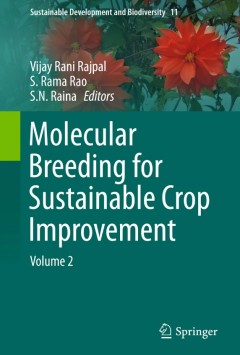Filter by

The Tomato Genome
This book describes the strategy used for sequencing, assembling and annotating the tomato genome and presents the main characteristics of this sequence with a special focus on repeated sequences and the ancestral polyploidy events. It also includes the chloroplast and mitochondrial genomes. Tomato (Solanum lycopersicum) is a major crop plant as well as a model for fruit development, and the av…
- Edition
- -
- ISBN/ISSN
- 978-3-662-53389-5
- Collation
- -
- Series Title
- -
- Call Number
- -

Molecular Breeding of Forage and Turf
This proceeding covers all the collected research data and presentations from the 8th International Symposium on the Molecular Breeding of Forage and Turf. The book explores themes in molecular breeding of forage and turf, including abiotic and biotic stresses, bioenergy and biorenewables, comparative genomics, emerging tools for forage and turf research, functional genetics and genomics and ge…
- Edition
- 1
- ISBN/ISSN
- 978-3-319-08713-9
- Collation
- XIII, 194
- Series Title
- -
- Call Number
- -

The Sorghum Genome
This book provides insights into the current state of sorghum genomics. It particularly focuses on the tools and strategies employed in genome sequencing and analysis, public and private genomic resources and how all this information is leading to direct outcomes for plant breeders. The advent of affordable whole genome sequencing in combination with existing cereal functional genomics data has…
- Edition
- -
- ISBN/ISSN
- 978-3-319-47789-3
- Collation
- -
- Series Title
- -
- Call Number
- -

Molecular Breeding for Sustainable Crop Improvement
The world population is estimated to reach to more than 10 billion by the year 2050. These projections pose a challenging situation for the agricultural scientists to increase crops productivity to meet the growing food demands. The unavailability and/or inaccessibility to appropriate gene pools with desired traits required to carry out genetic improvement of various crop species make th…
- Edition
- 1
- ISBN/ISSN
- 978-3-319-27088-3
- Collation
- XI, 478
- Series Title
- Sustainable Development and Biodiversity
- Call Number
- -

The Search for Wild Relatives of Cool Season Legumes
The study of origin and domestication of legumes described in this book emerged when it became apparent that while this kind of information is adequate for cereals, the pulses lagged behind. At the end of the 1960s the senior author initiated a study on the chickpea's wild relatives followed by similar attempts for broad bean, fenugreek, common vetch, bitter vetch, and lentil. The junior aut…
- Edition
- -
- ISBN/ISSN
- 978-3-319-14505-1
- Collation
- -
- Series Title
- -
- Call Number
- -

Elucidation of Abiotic Stress Signaling in Plants Functional Genomics Perspe…
Abiotic stresses such as high temperature, low-temperature, drought, and salinity limit crop productivity worldwide. Understanding plant responses to these stresses is essential for rational engineering of crop plants. In Arabidopsis, the signal transduction pathways for abiotic stresses, light, several phytohormones and pathogenesis have been elucidated. A significant portion of plant genomes …
- Edition
- 1
- ISBN/ISSN
- 978-1-4939-2540-7
- Collation
- 1 b/w illustrations, 26 illustrations in colour
- Series Title
- -
- Call Number
- -

Elucidation of Abiotic Stress Signaling in Plants Functional Genomics Perspe…
Abiotic stresses such as high temperature, low-temperature, drought, and salinity limit crop productivity worldwide. Understanding plant responses to these stresses is essential for rational engineering of crop plants. In Arabidopsis, the signal transduction pathways for abiotic stresses, light, several phytohormones and pathogenesis have been elucidated. A significant portion of plant genom…
- Edition
- 1
- ISBN/ISSN
- 978-1-4939-2211-6
- Collation
- 6 b/w illustrations, 29 illustrations in colour
- Series Title
- -
- Call Number
- -
 Computer Science, Information & General Works
Computer Science, Information & General Works  Philosophy & Psychology
Philosophy & Psychology  Religion
Religion  Social Sciences
Social Sciences  Language
Language  Pure Science
Pure Science  Applied Sciences
Applied Sciences  Art & Recreation
Art & Recreation  Literature
Literature  History & Geography
History & Geography